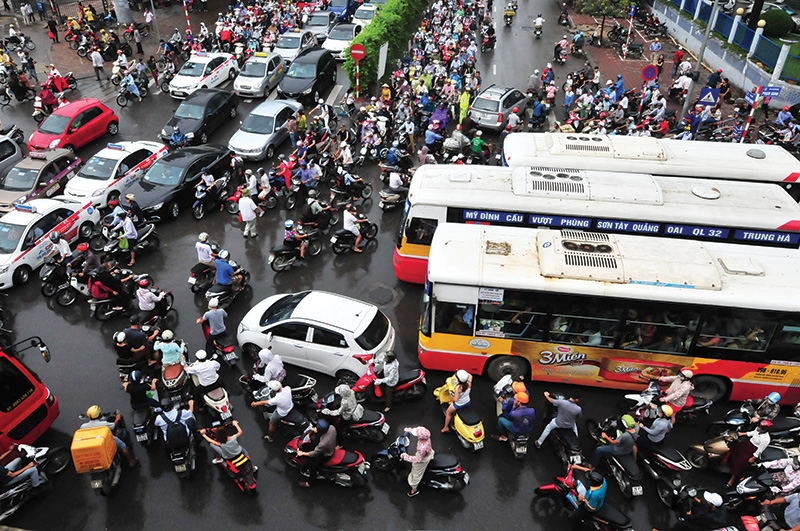
The make-up of Vietnam’s cities and other densely-populated areas has rapidly evolved over the past decade.
The nation’s march to prosperity continues with indicators such as GDP growth of 6.8 per cent, rise in foreign direct investment, strong retail sales, and international arrivals all increasing at rates above regional competitors.

By Troy Griffiths Deputy managing director Savills Vietnam.
After a 10-year interval from 2009, we can see how Vietnam has changed and how this will influence future trends. It is particularly valuable for the population movement and residential demand as housing is often referred to as the ‘engine room’ of a country’s economy because it touches and influences so many industries and so much of the population.
Vietnam today has the world’s 15th-highest population with a small land mass resulting in a high population density. This is great for functional and efficient economics as it means a strong labour force growth within a small land mass that is less expensive to service.
Vietnam’s population growth sits at 1.1 per cent, or 290 persons per square kilometre. This density is lower than the Philippines at circa 1.4 per cent, or 316 people over one sq.km, and far higher than Thailand that has almost stalled at 0.3 per cent, or 136 per person per sq.km.
Population growth is slowing in Vietnam and globally, as most countries are now moving past their demographic window and must consider their aging populations. But Vietnam’s competitive advantage lies in its population density.
Megacities and the emergence of the city state are contemporary urban economic terms, conceptualising the outcome of Industry 4.0, Artificial Intelligence, and the future of the vast urban megalopolis.
Urbanisation is the force that grows cities by moving the population from rural to urban areas. The entrenched global trend is toward urban living as we move from traditional agricultural economies through to digital urban equivalents.
Vietnam is very interesting as, on face value, urbanisation appears to be very low at 34.4 per cent compared to Thailand’s 50 per cent, the Philippines’ 47 per cent, and the 55 per cent of Indonesia.
The urbanisation future
So Vietnam theoretically has a long way to grow in urban populations in order to match regional trends. This is a confidence-building data point for developers who must now look to the future and secure land banks that will carry them over this next exciting growth period.
Fundamentally over the census period, another 7.6 million people or roughly 2.1 million dwellings should have been added. Across Hanoi and Ho Chi Minh City as the key urban centres, this comes in at slightly over 200,000 dwellings per annum.
Primary supply across both cities has not provided this volume, meaning masked accommodation or possibly pent up demand. The country’s interesting counterpoint is that the rate of change has remained relatively low, meaning the transition has been slower than many peers.
The entire nation has a reasonably close proximity to the long coastline. Interestingly, rural land holdings are small and fragmented, and both of these characteristics result in a more anchored rural population.
Combined with good agricultural and commodity prices over the census period, and low public sector productivity, this has slowed the expected urban drift to cities. In recent times, many of these variables have accelerated significantly, requiring census adjustment.
With Vietnam’s rapid development over the last five years then, it can be expected that urbanisation will accelerate further as more jobs are created in the cities, in turn fulfilling requirements for housing, office space, and all downstream land uses.
Naturally this comes with growing pains placed upon urban infrastructure systems such as water, sanitation, power, and transport. As more of the census becomes available, we will be able to better determine the housing typologies and demand for various land uses.

Residential movements
Momentum shifts in the Vietnamese residential market are derived from golden demographics and a positive economic outlook. Today, Ho Chi Minh City and Hanoi are undergoing rapid transformations which continue to catch up with regional neighbours elsewhere.
Ho Chi Minh City’s apartment market is underwritten by strong occupier demand, whilst the high-end segment is appealing to both local high-net-worth individuals as well as international purchasers. High levels of capital inflow, increasing numbers of foreign developers, and suitable policies will continue this pattern of growth.
Local authorities in Ho Chi Minh City have announced a limit on project development in its housing strategy towards 2020. However, it only applies to newly-registered projects – developments approved and in planning will still be processed. Identified future residential supply will meet the housing demand if planning processes are carried out smoothly.
Complicated and lengthy legal protocol in Vietnam can be a barrier for overseas developers. However, their presence has increased over the last two years and is expected to continue. This increase will bring higher international standards and leverage competitive supply within the market.
The eastern areas of Ho Chi Minh City remain some of the most exciting districts for investors, given strong infrastructure development.
Historical supply in the country’s cities has been predominantly C-grade dwellings. Handovers and launches will also be mostly C-grade. This is driven by owner-occupiers, who in Vietnam are not overly exposed to debt, so the chance of a housing bubble is low.
While C-grade has been the market driver, there are now many more launches of upper B- and A-grade apartments - in a few cases at eye-watering prices. New A-grade apartments tend to be located near the city centre and built to international standards.
So far, e-commerce is a minor part of the Vietnamese retail market, but this will inevitably change as one-third of Vietnamese are millennials, with e-commerce revenues slated to rise 40 per cent by 2025.
A strong uptrend in pricing has been observed in the last 10 years and the entry of new, quality projects, a higher average income and decent financing packages have all facilitated these positive changes.

















